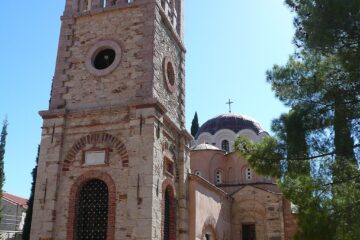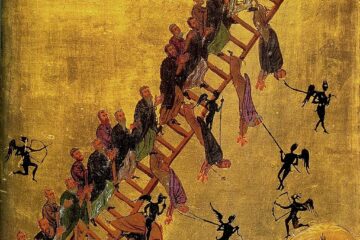The following in an excerpt from “Eros of Orthodoxy,” translated by Fr. Nicholas Palis and written by Mr. Pantelis Paschou.
There is a difference in the perception of the Crucifixion, amongst the Fathers of the East and of the West. Western Theology cries and wails inconsolably before the Crucified One, with lamentations and mourning revealing despair. All are drowned in silence, in catalytic mourning. And this clearly shows in their religious arts and in particular in paintings. How different though is the crucifixion of Orthodox iconography! Take a Crucifixion of the Macedonian or Cretan School, even today–as the indefatigable Kontoglou continues their tradition– you will see with what spirituality the martyrdom of the Cross is presented without anything earthly. The grief of Christ and the mourning of the Theotokos and of John, who stand by him, have something that softens the pain of death. Christ suffers, but his grief is not screaming, it is not choked in sobs. His appearance is serious, austere, held restrained.. And behind the Cross the Orthodox spiritual person can see a new life dawning.
And this is what makes the grief of the Cross take on a joyous meaning for the Christian. He sees the great Mystery of our salvation in the Cross. And with the god bearing Maximus the Confessor he recalls that everything that is visible needs to be crucified, and understands the relationship which they (the things seen and crucifixion) have between them.
“Joy/sadness” is a patristic word, which through Isaac the Syrian gives us its deep and broad meaning in the language of the ascetical and patristic philology. It is a word that is used and understood only amongst spiritually alive people. If your senses are not sanctified and can’t see the meaning of words and things, spiritually, you will always remain in the dead outer wrapping. “He who does not see and hear and sense spiritually, is dead according to the epigrammatic expression of Saint Gregory the Sinaite. Thus within Christianity there are “phenomena, which if we look at them within their spiritual epigram, are totally incomprehensible and we are in danger of falling into misunderstandings when we assume these.
Particularly, this saying of sacred Chrysostom could smooth out the ground of the joy/sadness of the Cross: “It is a time of grief, not when we suffer badly, but when we act badly”. Or also this saying of Saint Gregory the Theologian: “grief is more honorable than pleasure, and sadness than a celebration, and tears are praised rather than not good laughing”. Really, however, the meaning of the Cross’s joy/sadness underlies what the Crucifixion of Jesus on the “Place of Cross” represents for each one of us.
There are two interpretations of the Fathers for the place of Skulls. The first says that it was named “the place of Skulls” because there were always skulls of beheaded evildoers scattered over a great expanse, in that place George Koresios etc.). The 2nd refers to the tradition that where the Cross of Christ was placed, the body of Adam was buried: “because the skull of the First made man will be found, and the relic was lain, for this reason it was called the place of Skulls” in the expression of St. Epiphanios. “Because investigating the beginnings of human death in the said place of Skulls, it received the suffering wherein the beginning of man’s corruption was received, from there the life of the Kingdom shall begin (Basil the Great, the 5th vision of Isaiah). In his homily on Syria and Jerusalem the monk Epiphanios says the following as well: “Under Golgotha is a small Church (dwelling) of Adam, and in this was his skull under the crack of Golgotha. From whence it was named the place of Skulls”
The grief and despair that girds the souls of Christ’s disciples as He approaches his Passion, is something human. Although they saw many miracles, before the masses of fanaticized Jews they were confused, shaken, and in despair. One betrays, another becomes a denier, others seek first place in his “kingdom” others fell asleep in the garden of Gethsemane…
Under the shade of the Cross, where the Christians journey when they find themselves in the spiritual battle and personal fight with the opponent, they are obligated, to follow one road or the other. Our denials are daily. And our betrayals as well are not rare in comparison to the problems of our lives today. Despair stops at the Crucifixion. The West, with its much more humanistic character, overstresses (probably without always wanting to) the delivering work of Jesus. But the joy/sadness of the Orthodox Christian, always behind the bitter tear of the fall, sees, hopes and struggles for his resurrection. For this reason the Crucifixion does not at all hide the light and unspeakable spiritual beauty of the Resurrection to us.



0 Comments